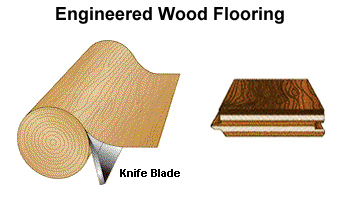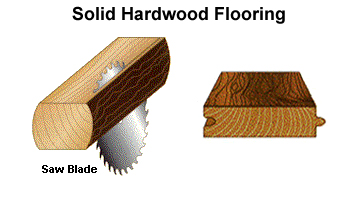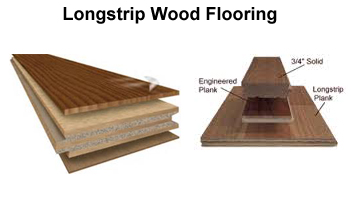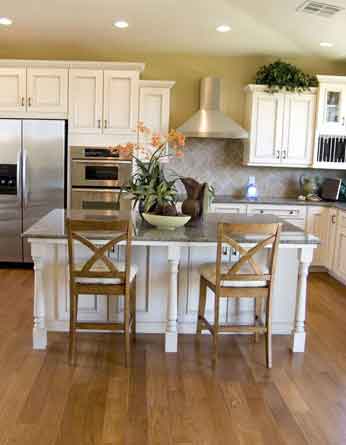Hardwood Flooring Construction
You know how a home is built. Here’s how a hardwood floor is constructed.
Knowing how hardwood floors are constructed can be very advantageous.
It enables you to understand the product’s materials right from the beginning.
Remember that these are materials you will be living with, and on, should you choose to have our hardwood flooring installed in your home.
Knowing the different hardwood choices and the methods of floor construction also helps you understand and evaluate their performance aspects: why certain hardwood floors are easier to install, for example.
Plus, perhaps most important, understanding hardwood floor construction can make you a smarter shopper, help you better determine hardwood value and keep you inside the borders of your home decorating budget.
So please read on, and we’ll do our best to help you understand how hardwood floors are constructed, the various types of construction methods, and the advantages and disadvantages of each for you and your home.
To begin, be aware of these hardwood sizes, species and types. When we think of solid wood floors we generally are talking about a 3/4" thick plank that is 2 1/4" wide.
This is the classic strip wood floor, although it is possible to find a narrower width or a slightly thinner gage. The strips are generally in random lengths from 12" – 84".
The most common wood species used for solid strip floors are red oak, white oak, maple, cherry, white ash, hickory or pecan.
And the three common types of wood floors are Engineered, Solid, and Longstrip Plank, each of which we will now address.
Type 1: Engineered for stability and moisture control.
Engineered wood floors are generally manufactured with 2,3, or 5 thin sheets or plies of wood that are laminated together to form one plank.
These wood plies are stacked on top of each other but in the opposite directions. This is called cross-ply construction which creates a wood floor that is dimensionally stable and less affected by moisture than a 3/4” solid wood floor.
In the presence of moisture, solid wood planks will always expand across the width of the planks, rather than down the length of the boards.
The advantage of cross-ply construction allows the plies to counteract each other, which will stop the plank from growing or shrinking with the changes in humidity.
The other advantage for you is versatility. You can install these floors over concrete slabs in your basement as well as anywhere else in you home.
Most engineered floors can be nailed down, stapled down, glued down, or floated over a wide variety of sub-floors, including some types of existing flooring.
Engineered floors will range from 1/4" to 9/16" in thickness, and vary from 2 1/4" to 7" in width. The widths can also be mixed, such as 3-5-7-inch planks installed side by side. By varying the board widths you can change the total appearance of the floor. Create a truly custom look for your home. The lengths will be random and range from 12" – 60" in length.
For design freedom, consider engineered.
Because engineered wood floors are made up of several layers of wood the top finish layer can be a totally different wood species. A variety of domestic or exotic hardwood species are available such as Oak, Maple, Hickory or Cherry. You’re free to pick the one that suits your style.
Type 2: the floor that’s solid yet expands.
Solid wood floors are one solid piece of wood that have tongue and groove sides. When we talk about solid wood floors, we tend to think of floors that are unfinished, but it’s important to know that there are also many pre-finished 3/4” solid wood floors.
And you should also be aware of the moisture factor.
Solid wood floors are sensitive to moisture and because so they are used in nail down installations and are not recommended for installation below ground level, or directly over a concrete slab.
The good news is that these floors can be refinished, or recoated, several times, which adds to their appeal and to their long life in your home.
In fact, there are solid floors that are over 100 years old that are still in good condition with rich patina and character – enhancing the beauty of the home.
Because they’re a natural product, hardwood flooring will expand and contract in response to seasonal changes in moisture. In the winter heating months, moisture leaves the wood causing the floor to contract, which creates larger than expected gaps between each plank.
In the summer months, when the humidity is higher, the wood will expand and the gaps will disappear. If there is too much moisture it may cause the wood planks to cup, or buckle. Not something you want in your home.
This is why it is important when installing a solid strip floor to leave the proper expansion area around the perimeter and to acclimate the wood prior to installation. This will help assure a lasting, beautiful application.
Consider oak, for all its choices.
Oak is commonly used for solid unfinished wood floors and there are several different qualities of oak for you to choose from. These qualities are clear, select and better, #1 common, and #2 common.
The clear has no visual blemishes or knots and is extremely expensive. While the select and better quality has some small knots and very little dark graining.
The #1 common and #2 common have more knots and more dark graining.
So be aware of that when buying an unfinished solid oak floor and make sure you know which quality of wood you are buying.
Type 3: Longstrip offers you unique possibilities.
Longstrip plank floors are similar to engineered floors and have several wood plies that are glued together. The center core is generally a softer wood material and is used to make the tongue and groove. A hardwood finish layer is glued on top of the core.
The top layer can be almost any hardwood species and is made up of many smaller individual pieces that are laid in three rows.
Longstrip planks are approximately 86" in length and 7 1/2" in width. They generally have between 17 and 35 pieces that make up the top layer of each board.
This gives the effect of installing a board that is 3 rows wide and several planks long. Each longstrip plank looks like an entire section that has already been pre-assembled for you. This alone can create a unique look all your own.
Longstrip planks are designed for the floating installation, but most can also be glued-down, or stapled down. Because these floors can be floated they are extremely versatile – they can go over a wide variety of sub-floors and on any grade level.
Like engineered floors, longstrip floors come in a wide variety of domestic and exotic hardwood species.
Longstrip plank floors have another advantage. When damaged, they can be replaced with relative ease. That’s an important consideration for active homes.
Those are the basics of hardwood flooring construction. We hope that the information we’ve featured here leads you to a better understanding of how this beautiful and versatile product is created, and makes you a better, smarter, more educated customer.
Type 1: Engineered

- made with 2,3, or 5 thin sheets laminated to form 1 plank
- plies stacked in opposite directions- cross-ply construction
- cross ply - dimensionally stable, less affected by moisture than 3/4” solid
- with moisture, solid planks expand across width not down length
- cross-ply advantage: plies counteract for plank growth, shrinking with humidity changes
- versatile: installed over concrete slabs or other places
- installed by: nailed down, stapled down, glued down, or floated
- over a wide variety of sub-floors, and some existing floors
- range: 1/4" to 9/16" thick
- width:2 1/4" to 7", mixed (3-5-7-inch planks installed side by side)
- varying widths can change the appearance
- lengths random: 12" – 60" in length
- made of layers - top finish layer is different species
- domestic or exotic species: Oak, Maple, Hickory or Cherry
Type 2: Solid

- one solid piece with tongue and groove sides
- unfinished and pre-finished 3/4” solid
- moisture factor: sensitive to moisture
- used in nail down installations
- not recommended for below ground level, or over a concrete slab
- can be refinished, or recoated, several times
- natural product: expand and contract with season changes (moisture)
- in winter heating months, moisture leaves the wood causing contraction this creates gaps between planks
- in summer months, with high humidity, wood expands meaning gaps disappear
- too much moisture causes planks to cup, or buckle
- important to leave expansion around the perimeter
- important acclimate prior to installation
- Oak: used for solid unfinished floors - several qualities
to choose from
- clear-no visual blemishes or knots, expensive
- select and better- some small knots, little dark graining
- #1 common, #2 common - more knots and dark graining
Type 3: Longstrip

- similar to engineered floors
- several wood plies glued together
- center core is softer, used to make the tongue and groove with finish layer on top of the core
- top layer: any species made up of smaller individual pieces laid in 3 rows
- 86" in length and 7 1/2" in width
- 17 and 35 pieces making up the top layer of each board
- each plank looks like a section already pre-assembled
- designed for the floating installation
- can be glued-down, or stapled down
- extremely versatile – can go over a variety of sub-floors and grade level
- come in a wide variety of domestic and exotic species
- advantage: when damaged, they can be replaced easily

